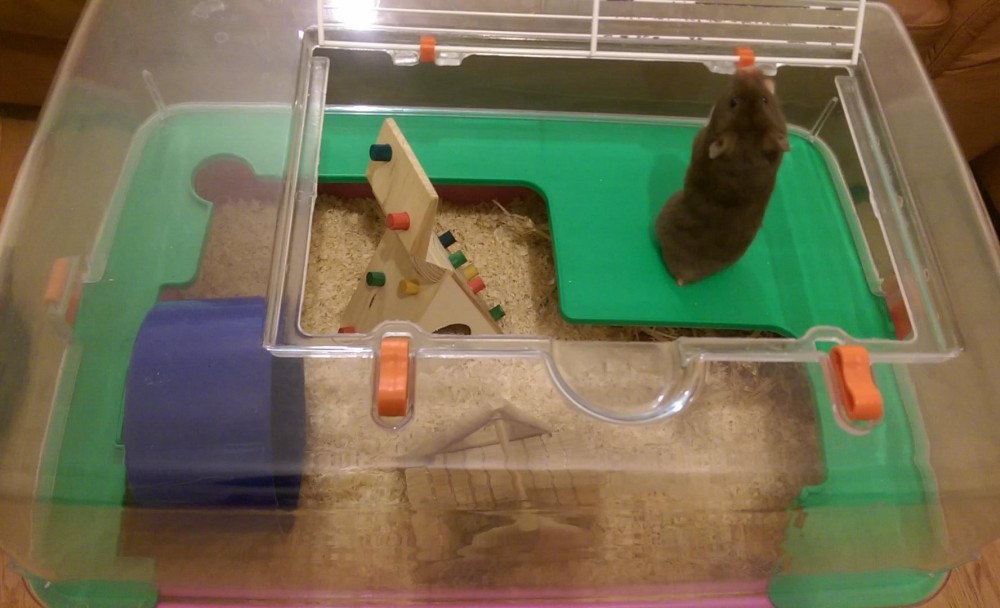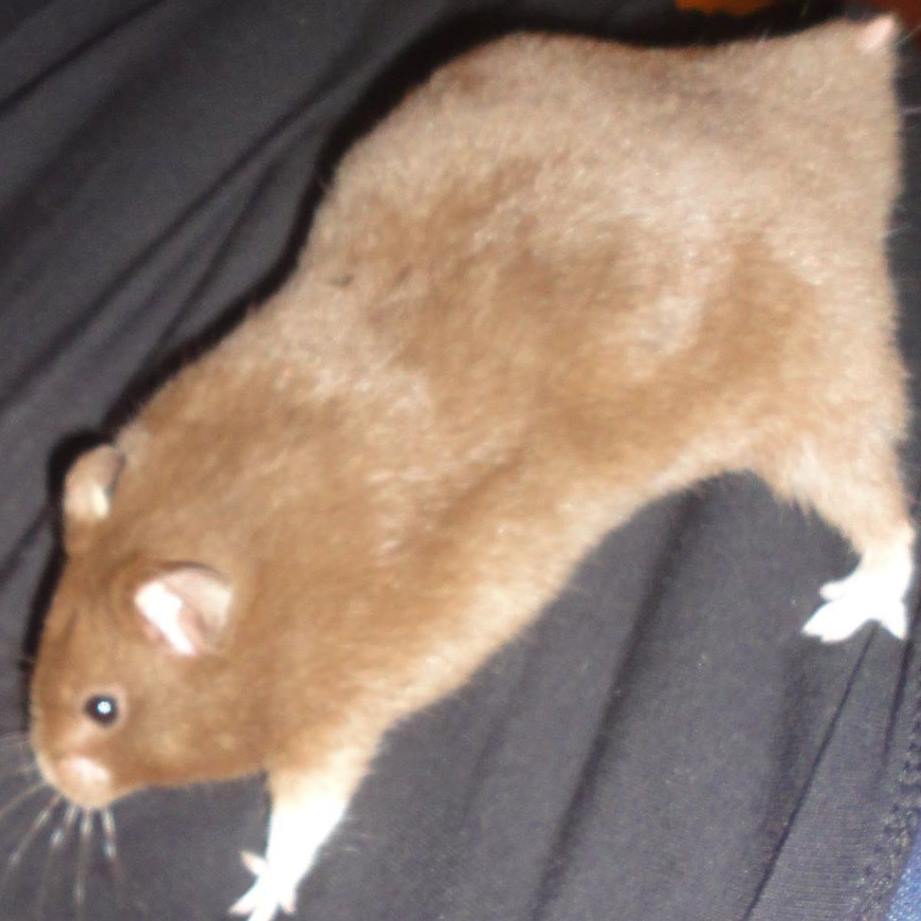Cuddly Critter Care
17:53
If you’re a frequent visitor here then you’ll know that I published a post on rabbit care in October (if not, you can find that post here: https://disasterdavis.wordpress.com/2015/10/19/hop-to-it/ ), it were proven helpful to some therefore I thought it a good idea to publish another, this time for a smaller cuddly critter. Whilst hamsters are considerably easier to care for than rabbits, there are maybe still some things that people are unsure of regarding the correct care for their small friends. I have vast experience of owning both Syrian and Russian Dwarf breeds therefore feel I’m able to give adequate tips and advice where appropriate on this matter.
Hamsters are a fantastic pet to choose for many reasons such as being easy to clean out, lower cost, easy to tame and not requiring much space in the home. If you’re taking a holiday they’re also much easier to plan for, as they can be transported to a trusted person’s home in their cage and easily cared for in your absence, no nonsense and no need for pet shelters or feeling tied to your home due to the responsibilities your pet creates. Hamsters are also a fantastic pet choice for children due to many of the reasons already touched upon. They will still need to be handled carefully of course and you should supervise your child whilst doing so in case the hamster manages to escape and run away or get lost. They can still bite and will do so when feeling threatened or will give you a slight nibble when getting settled into their new home, however this is purely to figure out who you are. When holding their pet, children should always sit somewhere as near to the floor as possible in the event that the pet may jump. Gloves are advised if you have a particularly aggressive hamster or if your child is extremely anxious, although this will hinder the bonding process if the animal is unable to become used to the scent of the handler. A negative to owning one is of course that they’re nocturnal and tend to sleep throughout the day, meaning you will probably barely see them! I’d also advise homing them in a living room rather than in a bedroom for this exact reason, furthermore hamsters will learn their owners voices and feel at home more quickly when not being hidden away and treat equal to that of a neglected after thought.
Habitat
First things first, your hamster is in need of an appropriate place to call home! This will need to of course include their food, water, things to do, gnaw sticks, wheel and a bedding area. Cages with lots to do are the best, with different levels and activities to stimulate your pet. When picking a cage think about cleaning, there are more simpler cages that still incorporate fun activities that will be easier to handle during the cleaning process than others. Also try to avoid anything with bars (unless this is the roof of the cage) as your little rascals legs can slip through these, getting stuck and potentially harming themselves. You will need a bedding area for your pet and it’s advised to use materials such as a shredded soft/cloth paper bedding rather than anything else as many materials (for instance wool) can become tangled around your hamsters organs when ingested. Paper based materials will disintegrate although double check ingredients to avoid anything with potentially harmful substances. Below is a picture of my current set up for my Syrian hamster, with a very happy, cute and inquisitive Jeremiah sneaking into the shot!
First things first, your hamster is in need of an appropriate place to call home! This will need to of course include their food, water, things to do, gnaw sticks, wheel and a bedding area. Cages with lots to do are the best, with different levels and activities to stimulate your pet. When picking a cage think about cleaning, there are more simpler cages that still incorporate fun activities that will be easier to handle during the cleaning process than others. Also try to avoid anything with bars (unless this is the roof of the cage) as your little rascals legs can slip through these, getting stuck and potentially harming themselves. You will need a bedding area for your pet and it’s advised to use materials such as a shredded soft/cloth paper bedding rather than anything else as many materials (for instance wool) can become tangled around your hamsters organs when ingested. Paper based materials will disintegrate although double check ingredients to avoid anything with potentially harmful substances. Below is a picture of my current set up for my Syrian hamster, with a very happy, cute and inquisitive Jeremiah sneaking into the shot!

Diet
You should be giving your hamster fresh food and water daily, regardless of how much they have left of either. Hamsters are notorious for stashing their food in their beds, therefore if you are unsure about how much food to be giving them, check in their bed when cleaning the cage to see if you might need to either increase or reduce the amount you’re providing them. For a more in depth look at what you can, can’t and should be feeding your little friend, please follow this link from the RSPCA as information of the utmost value is contained within this page! ( http://www.rspca.org.uk/adviceandwelfare/pets/rodents/hamsters/diet ) If you haven’t been bothered to check this out however, (you mustn’t really care that much about your pet and probably shouldn’t be getting one!), then please note that rhubarb and grapes are poisonous for rodents – don’t feed these items to your pet under any circumstance.
Happiness
The happiness of your friend depends on many factors, including stimulation, love and correct care. Hamsters (especially Syrian breeds) are incredibly friendly and inquisitive, they love to be social and interact with you. Please put in the time to socialise, you are all they know, it’s even worse for Syrian’s and other breeds which are unable to live with a mate. As I said before hamsters will learn the sounds of their owners voices which helps to create a bond, spend plenty of time talking calmly to them and hold them at least once a day after initially forming a bond and they have become tame. If you would like me to publish a post solely on bonding with your hamster then please don’t hesitate to ask, I would be more than delighted to oblige. Offer them plenty to play with, avoid housing them near any electrical items (the noises they transmit scare them), care for them correctly and give them plenty of love and you can’t go far wrong!
The happiness of your friend depends on many factors, including stimulation, love and correct care. Hamsters (especially Syrian breeds) are incredibly friendly and inquisitive, they love to be social and interact with you. Please put in the time to socialise, you are all they know, it’s even worse for Syrian’s and other breeds which are unable to live with a mate. As I said before hamsters will learn the sounds of their owners voices which helps to create a bond, spend plenty of time talking calmly to them and hold them at least once a day after initially forming a bond and they have become tame. If you would like me to publish a post solely on bonding with your hamster then please don’t hesitate to ask, I would be more than delighted to oblige. Offer them plenty to play with, avoid housing them near any electrical items (the noises they transmit scare them), care for them correctly and give them plenty of love and you can’t go far wrong!

Health
There’s a catalogue abundant with health issues your little friend can have and so many different ways to observe that your pet is unwell, including visible signs or a change in their behaviour. You know your hamster the best therefore will know ultimately if something doesn’t seem quite right, although if they have a loss of appetite, either a lack of or are excessively drinking, a lack of exercise and activity, itching, sneezing or aren’t keeping themselves clean, then this is probably a sure indicator that something could be wrong. Other things to observe are any noticeable problems with their eyes, hair loss, sores, discharge, enlargement of any area, breathing (difficult, labored or rapid) and changes to their excrement such as suffering from diarrhea, or potentially having constipation if you notice that they seem to have less feces in their cage than usual. An adept vet should be easily able to identify any problems, check first for vet surgeries for a vet knowledgeable of small animals, also always find a vet before any problems arise, ensuring you are able to get your animal seen to quickly and minimizing extra pressure on yourself due to the need to find a vet at short notice. Being prepared is always the best option. Also different breeds are more prone than others to particular viruses, infections and health problems – some simple research on the specific breed will bring you many answers and a wealth of knowledge, it’s always good to know as much as you can about any animal you give a home to.
There’s a catalogue abundant with health issues your little friend can have and so many different ways to observe that your pet is unwell, including visible signs or a change in their behaviour. You know your hamster the best therefore will know ultimately if something doesn’t seem quite right, although if they have a loss of appetite, either a lack of or are excessively drinking, a lack of exercise and activity, itching, sneezing or aren’t keeping themselves clean, then this is probably a sure indicator that something could be wrong. Other things to observe are any noticeable problems with their eyes, hair loss, sores, discharge, enlargement of any area, breathing (difficult, labored or rapid) and changes to their excrement such as suffering from diarrhea, or potentially having constipation if you notice that they seem to have less feces in their cage than usual. An adept vet should be easily able to identify any problems, check first for vet surgeries for a vet knowledgeable of small animals, also always find a vet before any problems arise, ensuring you are able to get your animal seen to quickly and minimizing extra pressure on yourself due to the need to find a vet at short notice. Being prepared is always the best option. Also different breeds are more prone than others to particular viruses, infections and health problems – some simple research on the specific breed will bring you many answers and a wealth of knowledge, it’s always good to know as much as you can about any animal you give a home to.
On an end note, never house two hamsters together unless you have been told already by somebody trustworthy and experienced that the breed you have can live together, most breeds will kill one another and even when homing breeds that can cohabitate please be mindful of if you have bought the animals together and from the same breed, also watch them closely for any major squabbles and ding dongs as it can turn nasty! In other words, proceed with caution.
I hope this has been helpful for you, please contact me with any further questions you may have about any aspect of their care, I would be more than happy to go into further detail for you.
With Love,
Disaster Davis x
Disaster Davis x
Further Reading!
http://www.rspca.org.uk/adviceandwelfare/pets/rodents/hamsters/diet
https://www.hamsters-uk.org/content/view/29
http://www.rspca.org.uk/adviceandwelfare/pets/rodents/hamsters/diet
https://www.hamsters-uk.org/content/view/29
(Original Post on WordPress)



0 comments
Lets Chat!